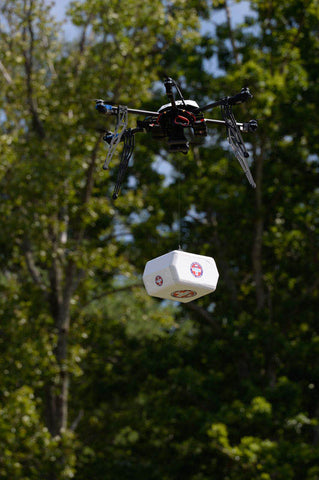Drone Payload Delivery | The Next Frontier in Humanitarian Relief
Drone payload delivery has been a hot button topic since Amazon CEO, Jeff Bezos, announced the company’s plans for a delivery service in December of 2013. Drone payload delivery has been of interest in the realm of commerce, but it’s possible that humanitarian relief will be the next frontier for drone delivery systems.
In 2015, the Federal Aviation Administration (FAA) approved the first drone payload delivery, which involved the dropoff of medicine to a free medical clinic in Southwest Virginia operated by the Health Wagon, a health care outreach organization, and Remote Area Medical, an international nonprofit humanitarian group. The researchers behind this initial drone payload delivery have their eyes set on the use of drone technology for humanitarian use.
The delivery took 24 packages of medicine and medical supplies to the area typically served by mountain road in Wise County, VA. After flying in the supplies, a hexacopter drone operated by Australian startup, Flirtey, and outfitted with KDE Direct motors, flew the packages 0.7 miles to the health clinic. The one-way flight took two and a half minutes and three trips to get all 24 packages delivered.
Drone Payload Delivery for Humanitarian Relief
 The U.S. Agency for International Development (USAID), the government’s arm for funding international relief projects, has done extensive research on the feasibility of using drones to deliver medical supplies in hard to reach areas of Ethiopia. Based on their findings, this could lead to the creation of drone delivery networks elsewhere.
The U.S. Agency for International Development (USAID), the government’s arm for funding international relief projects, has done extensive research on the feasibility of using drones to deliver medical supplies in hard to reach areas of Ethiopia. Based on their findings, this could lead to the creation of drone delivery networks elsewhere.
In this project, USAID looked for a drone that could perform vertical takeoff and landing, operate autonomously, execute pre-programmed missions daily and have a range of at least 93 miles. The drones are required to have the payload capacity to carry units of blood, drugs, or light equipment at high altitudes. According to the World Bank, 81% of the country’s population lives in rural areas. Drone payload delivery could make a large difference in an emergency situation.
Another drone payload delivery project funded by USAID was part of their Saving Lives at Birth initiative. The Ifakara Health Institute in Tanzania experimented with using a drone to deliver blood needed for life saving transfusions. Another project, the first of its kind funded by USAID, used a drone to map the diamond mining industry in Western Guinea.
From delivering medical supplies to remote mountainous outposts to transporting blood samples, drone payload delivery has huge potential for a variety of humanitarian efforts.
At KDE Direct, we’re excited to see how the uses of drones is constantly expanding. With the possibilities in the realm of humanitarian relief, drone payload delivery could make a huge difference to many throughout the world.
Photo and Video Credit: Flirtey
Share this post
- Tags: delivery, heavy lift, humanitarian, payload




